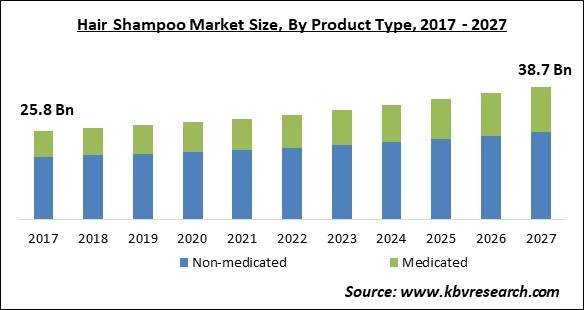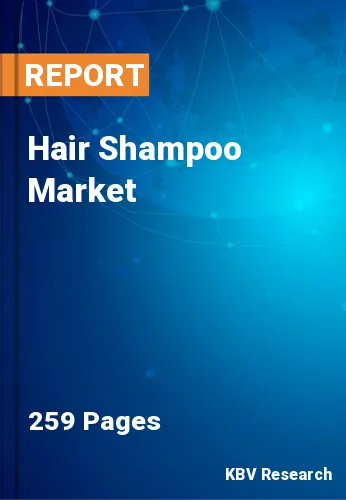The Global Hair Shampoo Market size is expected to reach $38.7 billion by 2027, rising at a market growth of 4.7% CAGR during the forecast period.
Shampoos are viscous-type items that are normally in the form of a liquid and are designed to clean the hair and scalp while also removing excess sebum from the hair follicles. Shampoos are made by combining different components including Sodium Laureth Sulfate, Cocamide MEA, Cocamidopropyl Betaine, Dimethicone, and much more.
In addition, these products are added into hair shampoos for multiple jobs such as Cosurfactant for lathering, Pearling agent, and cleansing agent, etc. They function as cleansing or foaming agents, removing pollutants from the hair. The shampoo contains chemicals that are comparable to those found in soap. Shampoo components, on the other hand, are designed to be less harmful on hair and preserve the outer layer from damage.
Moreover, manufacturers nowadays, are introducing a wide range of shampoos that can be used for multiple purposes. This broad line of shampoos is being rolled out in order to fulfill the diversified and evolving demands of customers for products varying in accordance with their hair-related requirements. For instance, shampoos for thickening of hair, shampoos treating greasy hair, clarifying shampoos that are being used to remove other hair styling products such as gel, spray, and wax.
The competitive behavior of key market players as well as existing large-sized, small-sized, and medium-sized hair shampoo vendors would result in enhancements in the pricing policy of the product and is estimated to make these products more affordable and accessible. These factors would play a major role in driving the growth of the hair shampoo market across the world.

The diffusion of the novel coronavirus is identified as the origin of the most demolished state of all the primary, secondary, and tertiary occupations, in decades. The COVID-19 delivered its impact to every part of the world and its economies. Consumer’s interest in natural ingredient-based hair shampoo products grew as a result of the rampant infection. Due to the risk of infection on the scalp and hair, a majority of customers avoided buying artificial ingredient and preservative-based hair shampoo products prior to the beginning of the pandemic.
The COVID-19 pandemic has shifted the demand for more important products in the short term, wherein people have started spending less on personal grooming products like shampoo. Consumers are opting for more DIY at-home products as a result of the closure of numerous retail shops, which has resulted in a negative growth rate. However, sales have increased as a result of the shift to the online channel and other unlock efforts.
Due to the rising diseases and problems regarding hair, the consumers’ demand for products that individually emphasize the specific hair care problem, is continuously increasing. In response to this, hair care product manufacturers are now expanding their portfolios with specific problem-oriented products in order to meet the consumers’ demand.
With the increasing purchasing power of the consumers across the world, the demand for many non-essential and luxurious products would also surge in the coming years. In addition, the rising living standards of the consumer is enabling them to spend more on hair and skin products. Additionally, the health of the scalp is degraded due to a variety of variables, including changes in climatic conditions, work type, eating habits, and others.
The demand for hair shampoos is expediting across the world along with that, companies are also determined to meet the requirements of their customers. However, this increased demand is becoming a reason for the increasing number of counterfeit products that include harmful ingredients in their products. In addition, Hair cleansers containing hazardous substances that claim to have desired results and are available at a reduced cost have resulted in a number of negative consequences on the scalp and hair growth.

By Distribution channel, the Hair shampoo market is segregated into Hypermarkets & Supermarkets, Drug Stores or Pharmacy, Mass Merchandiser, Departmental Stores, Mono-brand Stores, Specialty Stores, and Online Sales Channel. Mass Merchandiser segment procured a substantial revenue share in the hair shampoo market in 2020. It is owing to the fact that this distribution channel enables business that offers huge volumes of items at a low cost to a wide range of customers.
Based on the End-user, the hair shampoo market is divided into Men, Women, and Kids. The men segment procured a significant revenue share in the hair shampoo market in 2020. It is owing to the rising focus of men on grooming along with the increasing spending by men on personal skin and hair care products.
On the basis of Product type, the Hair shampoo market is bifurcated into Medicated and Non-Medicated. In 2020, the Non-Medicated segment acquired the largest revenue share in the hair shampoo market. The increased demand for this segment is owing to the fact that these shampoos are used on a daily basis by customers. Non-Medicated shampoos are regular-use products that are majorly being demanded among customers due to their function of offering hygiene and a clean and gentle look to the hair.
By type, the hair shampoo market is fragmented into premium and non-premium. It is because most of the premium hair shampoos do less or zero damage to the customers’ hair. In addition, the rise in the disposable income level of the consumers is enabling them to spend on premium skin and hair products.
| Report Attribute | Details |
|---|---|
| Market size value in 2020 | USD 28.3 Billion |
| Market size forecast in 2027 | USD 38.7 Billion |
| Base Year | 2020 |
| Historical Period | 2017 to 2019 |
| Forecast Period | 2021 to 2027 |
| Revenue Growth Rate | CAGR of 4.7% from 2021 to 2027 |
| Number of Pages | 259 |
| Number of Tables | 463 |
| Report coverage | Market Trends, Revenue Estimation and Forecast, Segmentation Analysis, Regional and Country Breakdown, Competitive Landscape, Companies Strategic Developments, Company Profiling |
| Segments covered | Type, Product Type, Distribution Channel, End User, Region |
| Country scope | US, Canada, Mexico, Germany, UK, France, Russia, Spain, Italy, China, Japan, India, South Korea, Singapore, Malaysia, Brazil, Argentina, UAE, Saudi Arabia, South Africa, Nigeria |
| Growth Drivers |
|
| Restraints |
|
Based on the Region, the Hair shampoo market is analyzed across North America, Europe, APAC, and LAMEA. Europe emerged as the leading region in the hair shampoo market with the largest revenue share in 2020. It is due to increased concerns about scalp damage, frizzy hair, and split ends. In addition, hair coloring trends in the region will lead to increased use of color-safe hair washes.
Free Valuable Insights: Global Hair Shampoo Market size to reach USD 38.7 Billion by 2027

The major strategies followed by the market participants are Product Launches. Based on the Analysis presented in the Cardinal matrix; The Procter and Gamble Company and Johnson & Johnson are the forerunners in the Hair Shampoo Market. Companies such as Kao Corporation, Marico Limited and Natura & Co Holding SA are some of the key innovators in the Market.
The market research report covers the analysis of key stake holders of the market. Key companies profiled in the report include L'Oreal Group, Estee Lauder Companies, Inc., Johnson & Johnson, The Procter and Gamble Company, Unilever PLC, Henkel AG & Company, KGaA, Kao Corporation, Marico Limited, Oriflame Cosmetics Global SA (Oriflame Holding AG) (Oriflame Investment Holding Plc) (Oriflame Holding Ltd), and Natura & Co Holding SA.
By Distribution Channel
By End User
By Product Type
By Type
By Geography
The hair shampoo market size is projected to reach USD 38.7 billion by 2027.
Increasing disposable income of the consumers are driving the market in coming years, however, the expanding width of the range of the product limited the growth of the market.
L'Oreal Group, Estee Lauder Companies, Inc., Johnson & Johnson, The Procter and Gamble Company, Unilever PLC, Henkel AG & Company, KGaA, Kao Corporation, Marico Limited, Oriflame Cosmetics Global SA (Oriflame Holding AG) (Oriflame Investment Holding Plc) (Oriflame Holding Ltd), and Natura & Co Holding SA.
The Drug Stores or Pharmacy market is generating high revenue in the Global Hair Shampoo Market by Distribution Channel 2020, thereby, achieving a market value of $8.6 billion by 2027.
The Medicated market shows highest growth rate of 6.3% during (2021 - 2027). The growth of this segment is attributed to natural and beneficial components that are being comprised in it.
The Medicated market shows highest growth rate of 6.3% during (2021 - 2027). The growth of this segment is attributed to natural and beneficial components that are being comprised in it.
Our team of dedicated experts can provide you with attractive expansion opportunities for your business.

